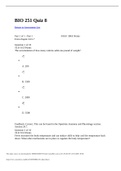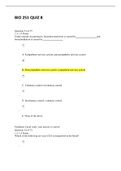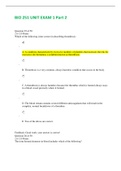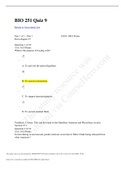Bio 251 quiz 8 Study guides, Class notes & Summaries
Looking for the best study guides, study notes and summaries about Bio 251 quiz 8? On this page you'll find 10 study documents about Bio 251 quiz 8.
All 10 results
Sort by

-
BIO 251 Quiz 8 - Questions and Answers
- Exam (elaborations) • 8 pages • 2023
- Available in package deal
-
- $13.49
- + learn more
BIO 251 Quiz 8 - Questions and Answers
![[GRADED] BIO 251 Quiz 6 /(100.0/ 100.0 Points) Questions And Answers. A+ Guide | American Military University](/docpics/6151f2f6862a3_1312303.jpg)
-
[GRADED] BIO 251 Quiz 6 /(100.0/ 100.0 Points) Questions And Answers. A+ Guide | American Military University
- Exam (elaborations) • 8 pages • 2021
- Available in package deal
-
- $10.99
- + learn more
BIO 251 Quiz 6 Return to Assessment List Part 1 of 1 - Part 1 100.0/ 100.0 Points From chapter 26.1-3 Question 1 of 10 10.0 / 10.0 Points The largest amount of water leaves the body throug h this route. • A. The skin as sweat. • B. The GI tract. • C. The lungs through expiration. • D. The kidneys via urine. Feedback: Correct. This can be found in the OpenStax Anatomy and Physiology section. Section 26.2. Question 2 of 10 10.0 / 10.0 Points Solute contributes to the movement of water betw...

-
BIO 251 FINAL PART 3,( 2022 ) Answered 100% correct.
- Exam (elaborations) • 20 pages • 2022
-
- $17.50
- + learn more
BIO 251 QUIZ 8 Question 51 of 75 1.5/ 1.5 Points Under normal circumstances, bronchoconstriction is caused by and bronchodilation is caused by . • A. Sympathetic nervous system; parasympathetic nervous system • B. Parasympathetic nervous system; sympathetic nervous system • C. Voluntary control; involuntary control • D. Involuntary control; voluntary control • E. None of the above Feedback: Good work; your answer is correct! Question 52 of 75 1.5/ 1.5 Points Which of ...

-
BIO 251 FINAL PART 3, Answered 100% correct.
- Exam (elaborations) • 20 pages • 2022
-
- $15.19
- + learn more
BIO 251 QUIZ 8 Question 51 of 75 1.5/ 1.5 Points Under normal circumstances, bronchoconstriction is caused by and bronchodilation is caused by . • A. Sympathetic nervous system; parasympathetic nervous system • B. Parasympathetic nervous system; sympathetic nervous system • C. Voluntary control; involuntary control • D. Involuntary control; voluntary control • E. None of the above Feedback: Good work; your answer is correct! Question 52 of 75 1.5/ 1.5 Points Which of ...
![[SOLVED] BIO 251 BIO 251 Quiz 8. Questions and answer (well explained) | Download To Score A.](/docpics/6151f7e266a88_1312357.jpg)
-
[SOLVED] BIO 251 BIO 251 Quiz 8. Questions and answer (well explained) | Download To Score A.
- Exam (elaborations) • 20 pages • 2021
- Available in package deal
-
- $10.99
- + learn more
BIO 251 QUIZ 8 Question 51 of 75 1.5 / 1.5 Points Under normal circumstances, bronchoconstriction is caused by and bronchodilation is caused by . • A. Sympathetic nervous system; parasy mpathetic nervous system • B. Parasympathetic nervous system; sympathetic nervous system • C. Voluntary control; involuntary control • D. Involuntary control; voluntary control • E. None of the above Feedback: Good work; your answer is correct! Question 52 of 75 1.5 / 1.5 Points Which of the following a...

-
BIO 251 UNIT EXAM 1,2 & final exams / QUIZ 1 - 8 BUNDLE (latest updates) | American Military University | Download To Score An A.
- Package deal • 13 items • 2021
-
- $18.49
- + learn more
[GRADED] BIO 251 UNIT EXAM 1,2 & final exams / QUIZ 1 - 8 BUNDLE (latest updates) | American Military University | Download To Score An A.

-
BIO 251 Quiz 3. Questions and Answers. 100.0/ 100.0 Points (From chapter 20 (20.1-20.6) | American Military University
- Exam (elaborations) • 9 pages • 2021
- Available in package deal
-
- $10.99
- + learn more
BIO 251 Quiz 3 Return to Assessment List Part 1 of 1 - Part 1 100.0/ 100.0 Points From chapter 20 (20.1-20.6) Question 1 of 10 10.0 / 10.0 Points Capillaries that have a perforated lining are called . • A. Perforated capillaries • B. Sinusoid capillaries • C. Continuous capillaries • D. Gap Capillaries • E. Fenestrated capillaries Feedback: Good work; your answer is correct! Question 2 of 10 10.0 / 10.0 Points These control the blood flow through a capillary bed. • A. Precapillary sp...

-
{SOLVED} BIO 251 Quiz 5. (100.0/ 100.0 Points) From chapter 21 (21.1-21.7) | American Military University
- Exam (elaborations) • 9 pages • 2021
- Available in package deal
-
- $10.99
- + learn more
BIO 251 Quiz 4 Return to Assessment List Part 1 of 1 - Part 1 100.0/ 100.0 Points From chapter 21 (21.1-21.7) Question 1 of 10 10.0 / 10.0 Points The cells responsible for humoral immunity are the . • A. Helper T cells • B. Natural killer cells • C. platelets • D. erythrocytes • E. B cells Feedback: Good work; your answer is correct! Question 2 of 10 10.0 / 10.0 Points Antibodies: • A. Require haptens to function • B. Make up part of the primary immune system • C. Are made from T...
![[SOLVED] BIO 251 BIO 251 Quiz 7. Questions and answer (well explained) | Download To Score A.](/docpics/6151f6796fca3_1312343.jpg)
-
[SOLVED] BIO 251 BIO 251 Quiz 7. Questions and answer (well explained) | Download To Score A.
- Exam (elaborations) • 9 pages • 2021
- Available in package deal
-
- $10.99
- + learn more
BIO 251 Quiz 7 Return to Assessment List Part 1 of 1 - 100.0/ 100.0 Points From chapter 23 (23.1-23.7) Question 1 of 10 10.0 / 10.0 Points Which are three features of the mucosa and submuc osa that are different and unique to the small intestine? • A. Microvilli, villi, and rugae • B. Villi, lateals, and rugae • C. Circular folds, villi, and microvilli • D. Haustra, circular folds, villi • E. All the above are features of the small intestine Feedback: Good work; your answer is correct!...

-
BIO 251 Quiz 9. Questions And Answers. A+ Guide
- Exam (elaborations) • 8 pages • 2021
- Available in package deal
-
- $10.99
- + learn more
BIO 251 Quiz 9 Return to Assessment List Part 1 of 1 - Part 1 100.0/ 100.0 Points From chapter 27 Question 1 of 10 10.0 / 10.0 Points What is the purpose of Leydig cells? • A. To a ctivate the sperm flagellum. • B. To secrete testosterone. • C. To support spermatogenesis. • D. To secrete seminal fluid. Feedback: Correct. This can be found in the OpenStax Anatomy and Physiology section. Section 27.1. Question 2 of 10 10.0 / 10.0 Points In men during sexual arousal, penile erections occur ...

Do you wonder why so many students wear nice clothes, have money to spare and enjoy tons of free time? Well, they sell on Stuvia! Imagine your study notes being downloaded a dozen times for $15 each. Every. Single. Day. Discover all about earning on Stuvia


